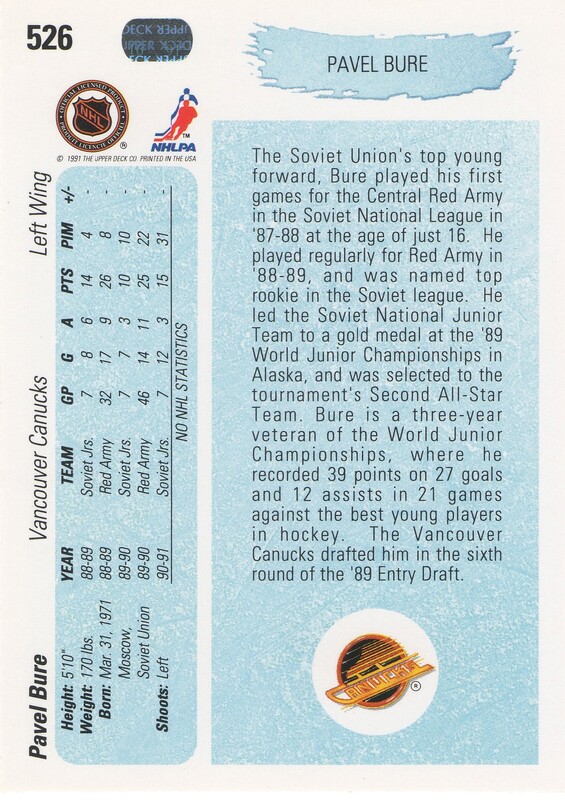Countdown (4/4)
100%
Upper Deck
|
1990-91 Upper Deck #526
|
1990-91 Upper Deck French #526
|
|
1990-91 Upper Deck Hologram Back #526
|
1990-91 Upper Deck Hologram Back French #526
|
This is where the adventure begins for me.
1990-91 marks the first cards printed with Pavel Bure in it. Bure came in the NHL at age 20. Selected 113th overall in the 1989 NHL draft by the Vancouver Canucks, he played his first NHL game on November 5th, 1991, a 3-3 tie against the Winnipeg Jets.
In the hockey card universe, 1990-91 was a breakthrough year. Before that, Topps and O-Pee-Chee ruled the market. Panini stickers and food companies like Vachon, Kellogg's, Neilson, Kraft, along with Esso and 7-Eleven created some sets in the '80s. For collectors, there were not many choices.
But that'll change in the turning of the new decade. Four new sets appeared on the market: Bowman, Pro Set, Score and of course, Upper Deck. I'm not going to write the pedigree of the first three (for now) because Bure didn't appear in those sets that year, but it's another story with the fourth one.
1990-91 marks the first cards printed with Pavel Bure in it. Bure came in the NHL at age 20. Selected 113th overall in the 1989 NHL draft by the Vancouver Canucks, he played his first NHL game on November 5th, 1991, a 3-3 tie against the Winnipeg Jets.
In the hockey card universe, 1990-91 was a breakthrough year. Before that, Topps and O-Pee-Chee ruled the market. Panini stickers and food companies like Vachon, Kellogg's, Neilson, Kraft, along with Esso and 7-Eleven created some sets in the '80s. For collectors, there were not many choices.
But that'll change in the turning of the new decade. Four new sets appeared on the market: Bowman, Pro Set, Score and of course, Upper Deck. I'm not going to write the pedigree of the first three (for now) because Bure didn't appear in those sets that year, but it's another story with the fourth one.
With many new products, the hype for hockey cards exploded in Canada, as well as in the United States. Companies, to reach as many collectors as possible, printed bilingual versions of their sets.
Consisting of 550 cards split into two series, Upper Deck arrived by storm in the industry with their stunning photographies, quality-made cards. But his landmark is surely the "Young Guns", which depicted photos of rookie players at the end of the set, in which Bure appear.
The cliché was taken when he won gold in the 1989 World Junior Championship in Alaska. In Russia, he played for CSKA Moscow, where he broke the record for most goals by a rookie in the Soviet League (17). This mark will last 18 years until Alexei Cherepanov scored 18 goals in 2006-07. Sadly, Cherepanov died at 19 years old in 2008 from heart failure during a KHL game.
Consisting of 550 cards split into two series, Upper Deck arrived by storm in the industry with their stunning photographies, quality-made cards. But his landmark is surely the "Young Guns", which depicted photos of rookie players at the end of the set, in which Bure appear.
The cliché was taken when he won gold in the 1989 World Junior Championship in Alaska. In Russia, he played for CSKA Moscow, where he broke the record for most goals by a rookie in the Soviet League (17). This mark will last 18 years until Alexei Cherepanov scored 18 goals in 2006-07. Sadly, Cherepanov died at 19 years old in 2008 from heart failure during a KHL game.
The hype was so crazy that Upper Deck decided after cases sold at a whopping price (Bure alone often sold for 300 $, a hockey card dealer told me once) to start the presses again and produced another large run.
So, to differentiate the early manufactured from the new batch, they put different holograms. For those printed in 1990, they have a distinguished "90", and for those printed in 1991, it has two "91".
I'm not 100% sure of this statement though (I've read that in an article a couple of years ago), that needs to be verified. But with all the speculations around that variation error, I don't know if this is right!
So, to differentiate the early manufactured from the new batch, they put different holograms. For those printed in 1990, they have a distinguished "90", and for those printed in 1991, it has two "91".
I'm not 100% sure of this statement though (I've read that in an article a couple of years ago), that needs to be verified. But with all the speculations around that variation error, I don't know if this is right!








